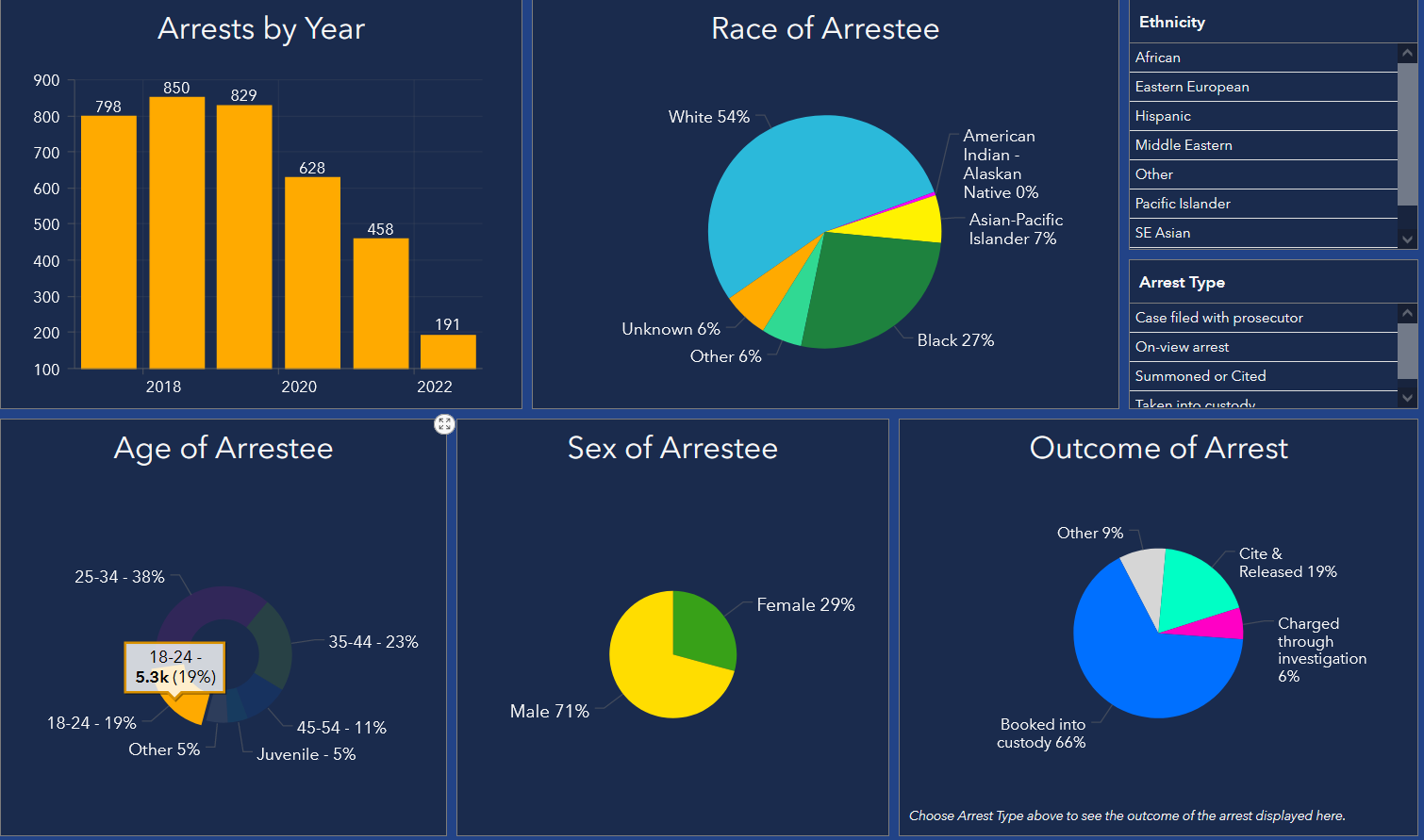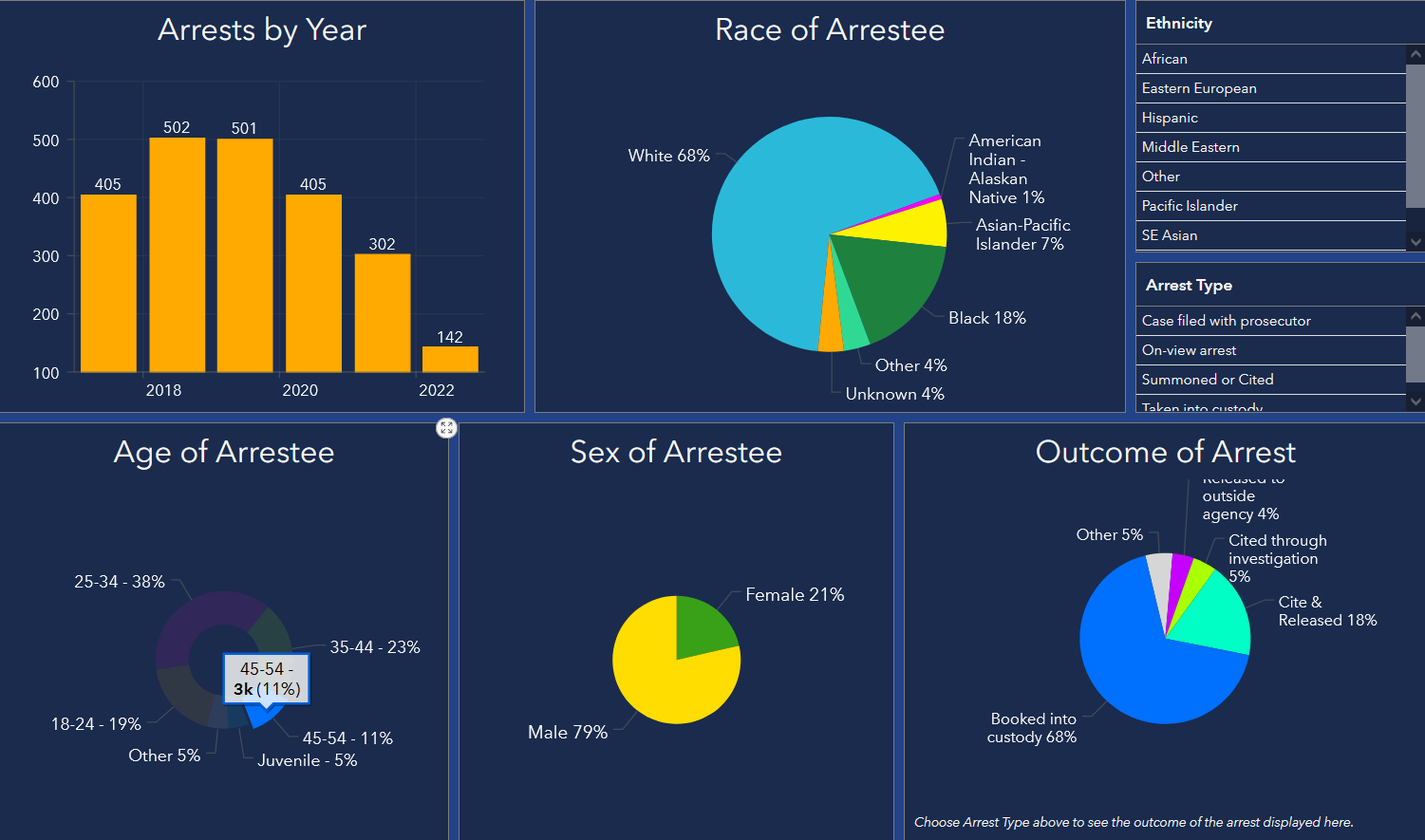In an effort to increase transparency and accountability to the community, Bellevue Police Department has published a new data dashboard which includes details on crime statistics, arrests, and uses of force by police officers. In a blog post last week, Chief Wendell Shirley shared, “We are happy to share this police data with our community members so they can become more aware of public safety issues… We continuously strive to earn the public’s trust and this website is another way to make a connection with our community.”
Community members interested in data like the racial breakdowns of departmental uses of force or arrests would previously have had to rely on public records requests. With the new portal, where data is updated every 48 hours, residents can more easily track trends and discover inequities in enforcement.
For example, the new portal reveals that, over the last five years, Black people have comprised 22% of the arrests in the city, despite only making up 2.6% of the Bellevue population as of the 2020 census. This trend persists regardless of whether the arrestee is a resident of Bellevue or of another nearby city. Additionally, one-quarter (25%) of the department’s uses of force during the same time period have been against Black people.

Importantly, because race data are likely recorded as how the officer perceives a subject rather than being based upon how that person self-identifies, it’s possible that officers may fail to correctly note a person as multiracial (a group which comprises 5.6% of the Bellevue population). However, even if this occurs at high rates, it cannot alone account for the disproportionate use of force from police that Black people in Bellevue experience.
Usefully, the dashboard includes a live filter function which allows users to further filter out statistics based on a subject’s race and age, the type of crime, and an arrest’s outcome. For example, one can further sort arrest data by age to discover that Black people comprise 27% of the arrests of people ages 18-24, but only 18% of those ages 45-54.


The launch of the data dashboard is just one part of a larger process that began shortly after the murder of George Floyd in May 2020 and the resulting nationwide protests. In response to calls for police reform, Mayor Lynne Robinson and the City Council initiated an independent review of the Police Department’s use of force policies, a process that culminated in an April 2021 report with 47 recommendations. These included updates to policy language in manuals, revisions to taser deployment tactics, improved data transparency, and others.
At the recent State of the City discussion, Deputy Mayor Nieuwenhuis claimed that all 47 recommendations from the OIR report had been implemented. However, some suggested policy revisions were ultimately rejected by Bellevue Police Department (BPD) or implemented with alteration. For example, at a quarterly briefing to Council in January, Chief Shirley announced that BPD would not implement recommendation number 34 to publish any munitions authorized for use by its Civil Disturbance Unit or SWAT team on the department’s website, claiming that such a procedure “could compromise [the department’s] opportunity to safely and effectively protect the community.”
Additionally, recommendation number 23 to restrict taser applications to five seconds was implemented but with significant modifications that weaken the effect of the policy change. The updated taser policy reads: “In most situations, officers should apply the TASER for only one standard cycle (5 seconds) and then assess the situation before applying any subsequent cycles. However, there may be times when it is necessary and objectively reasonable (due to the level and immediacy of the threat) for the officer to apply the TASER for longer than the standard cycle.” No additional context is provided for what criteria are needed in order to meet the threshold where longer taser deployments are allowed — this appears to be left to the officer’s discretion.
After the recommendations were published, the department committed to giving quarterly progress reports during City Council meetings, but the last such meeting was in mid-January, nearly six months ago. In lieu of a meeting in April, the department published a progress report which revealed that implementation of the remaining recommendations was in progress, but no completion date was provided. Chief Shirley has previously noted that the department was looking to complete implementation of its chosen policies by June, but it was noted at the time that union bargaining might impact the timetable.
Chief Shirley has led the department and overseen its use of force overhaul since former Chief Steve Mylett left to head Akron Police Department last summer. That department is facing scrutiny over officers’ killing of Jayland Walker and their handling of subsequent protests. Walker, a Black man, was shot at dozens of times by eight officers, seven of whom were White.
Chris is a UW Environmental Sciences graduate who moved to Bellevue in 2015. When he's not busy being an urbanist fox on the internet, he's working on the Eastside to support efforts reducing greenhouse gas emissions and going to city council meetings to denounce the hegemony of automobile infrastructure. Follow him on Twitter at @Deutski1.





